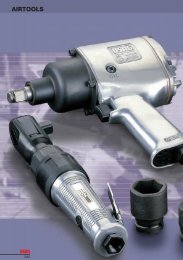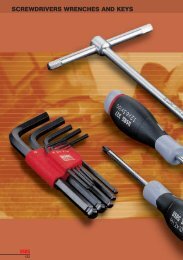Industrial seal self study guide - SKF.com
Industrial seal self study guide - SKF.com
Industrial seal self study guide - SKF.com
Create successful ePaper yourself
Turn your PDF publications into a flip-book with our unique Google optimized e-Paper software.
Lip Wear<br />
Look for clues in the <strong>seal</strong>ing member of the <strong>seal</strong>. A small cut, nick<br />
or abrasives continually laying at lip/shaft interface could be the source<br />
of the leak. But if everything looks intact, it’s time to look at the wear<br />
pattern of the lip (fig. 9g).<br />
Causes<br />
A new <strong>seal</strong> which has never been installed has a sharp edge at<br />
the contact point. Following a period of normal operation, the lip’s<br />
sharp edge will be flattened some by normal wear. If the lip has<br />
been substantially worn away, the <strong>seal</strong> may not be getting enough<br />
lubrication, the shaft may be corroded, the vent in the lube system<br />
may be blocked, or the finish too rough. Extreme wear could also be<br />
caused by shaft-whip (DRO). It could also be caused by excess<br />
pressure or by misalignment (STBM).<br />
A<br />
B<br />
Corrective Actions<br />
Check the shaft-to-bore alignment. Correct the alignment. Provide<br />
proper lube for the <strong>seal</strong> if there isn’t enough. Repair the shaft if the<br />
shaft is not properly finished. Use a <strong>seal</strong> designed to exclude abrasive<br />
contaminants if there is an abrasive build-up. Clean and open vents<br />
that are blocked to reduce pressure. If conditions warrant, consider<br />
using a <strong>seal</strong> designed for high pressure.<br />
Outer Case Damage<br />
A “curled” or rolled edge of the <strong>seal</strong> metal case indicates damage.<br />
The damaged zone may feel rough.<br />
Causes<br />
The housing bore may have a square corner or not have had a proper<br />
lead-in chamfer. Without it, the <strong>seal</strong> may bind on insertion. This can<br />
cause cocking or create a beveled or rolled end for part of its circumference.<br />
It’s also possible that the bore diameter and tolerance are<br />
incorrect.<br />
Corrective Actions<br />
Insure that the bore does not start with a square corner. Per industry<br />
standard, it should have a 15˚-30˚ angle and the corners should be<br />
smooth and free of burrs. Confirm that the bore size is correct for the<br />
<strong>seal</strong>.<br />
C<br />
The illustration above <strong>com</strong>pares<br />
the lip on a new <strong>seal</strong> (A) to one<br />
with normal wear (B) and one with<br />
excessive wear (C) (fig. 9g).<br />
Examining the Outer Shell<br />
No Chamfer<br />
The beveled edge (chamfer) on the<br />
leading edge of the bore provides a ramp<br />
for starting the <strong>seal</strong> straight. Without it,<br />
it is virtually impossible to get the <strong>seal</strong><br />
installed correctly. A 15˚-30˚ angle, clean<br />
and burr free, is re<strong>com</strong>mended. (fig. 9h).<br />
9<br />
81







